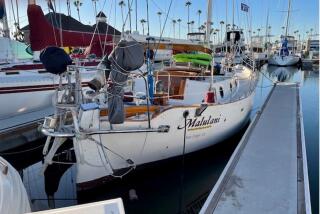Bobby Wilks dies at 78; first African American Coast Guard pilot
Bobby C. Wilks, the first African American Coast Guard aviator and the first African American to reach the rank of Coast Guard captain, died July 13 at an assisted-living community in Woodbridge, Va., of complications from Parkinson’s disease. He was 78.
Wilks, who also was the first African American to command a Coast Guard air station, pulled off a number of daring sea rescues around the world. He received the Air Medal for the initiative, foresight and aeronautical skill he exhibited on the night of Dec. 9, 1971, while piloting his helicopter over the Pacific. Battling gale-force winds and heavy seas, he was able to rendezvous with a Russian vessel 116 miles east of Hilo, Hawaii, and evacuate the ship’s critically ill master.
“He was right at the limit of where you can take a helicopter,” said Dallas Schmidt, a friend and fellow Coast Guard helicopter pilot at the time. Wilks was Schmidt’s flight instructor, or “air daddy.”
“Even though he was a commander and I was just an ensign, you never had the feeling that he was pulling rank on you,” Schmidt recalled. “He was just a nice, nice man.”
John “Bear” Moseley, who was in flight school with Wilks, recalled another near-miraculous open-sea landing Wilks executed in the summer of 1963.
He was dispatched to evacuate a critically ill seaman from the destroyer Mills near Cay Sal Bank off Cuba. Wilks directed the ship’s captain to increase his speed to 27 knots as a way of smoothing out the choppy waters so he could land his HU-16 Albatross, an amphibious plane, while taking care not to smash into the destroyer.
He brought the plane down in the ship’s wake, got the patient aboard and took off, despite being unable to use jet boosters to help lift the plane out of the water. He basically “ballooned the aircraft into the air . . . smacked the top of the next wave and then was airborne,” Moseley said, noting that then-lieutenant Wilks had to worry about banking the plane without stalling, so he wouldn’t hit the destroyer.
“He pushed the envelope to its very limit, and his skill brought men and machine home,” Moseley said.
Moseley said that in all the years he knew Wilks, he never talked about his pioneering role in the Coast Guard.
“I do not know, of course, what was in his mind, but outwardly our goals were the same -- to get our wings and be part of the best damn rescue service in the world,” he said.
Bobby Charles Wilks was born May 13, 1931, in St. Louis. After attending Stowe Teachers College, now Harris-Stowe State University, in St. Louis for two years, he was accepted into the Naval Academy.
He attended in 1950-51 before returning to Stowe, where he received his undergraduate degree. He also received a master’s in education from St. Louis University in 1954.
His Coast Guard career began in 1956, when, after receiving his commission at Coast Guard Officer Candidate School in New London, Conn., he was accepted to flight school and subsequently served in San Francisco, the Philippines, Brooklyn and other duty stations.
He accumulated more than 6,000 flight hours in 18 types of aircraft. He also was the project officer for the Sikorsky HH-3 helicopter when the craft was first delivered in the 1960s.
In addition, he was involved with minority recruiting for the Coast Guard Academy and was the Coast Guard liaison to the Federal Aviation Administration.
He made captain in 1977, and was commanding officer of the Coast Guard air station in Brooklyn.
Survivors include his wife of 42 years and a son.
Holley writes for the Washington Post.
More to Read
Start your day right
Sign up for Essential California for the L.A. Times biggest news, features and recommendations in your inbox six days a week.
You may occasionally receive promotional content from the Los Angeles Times.






